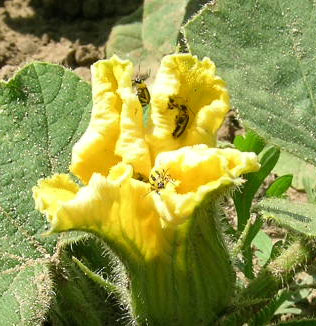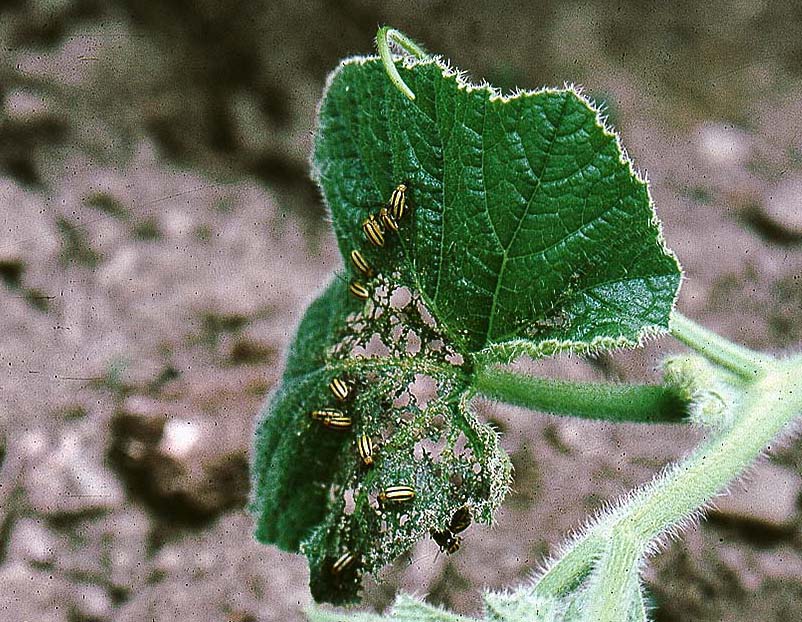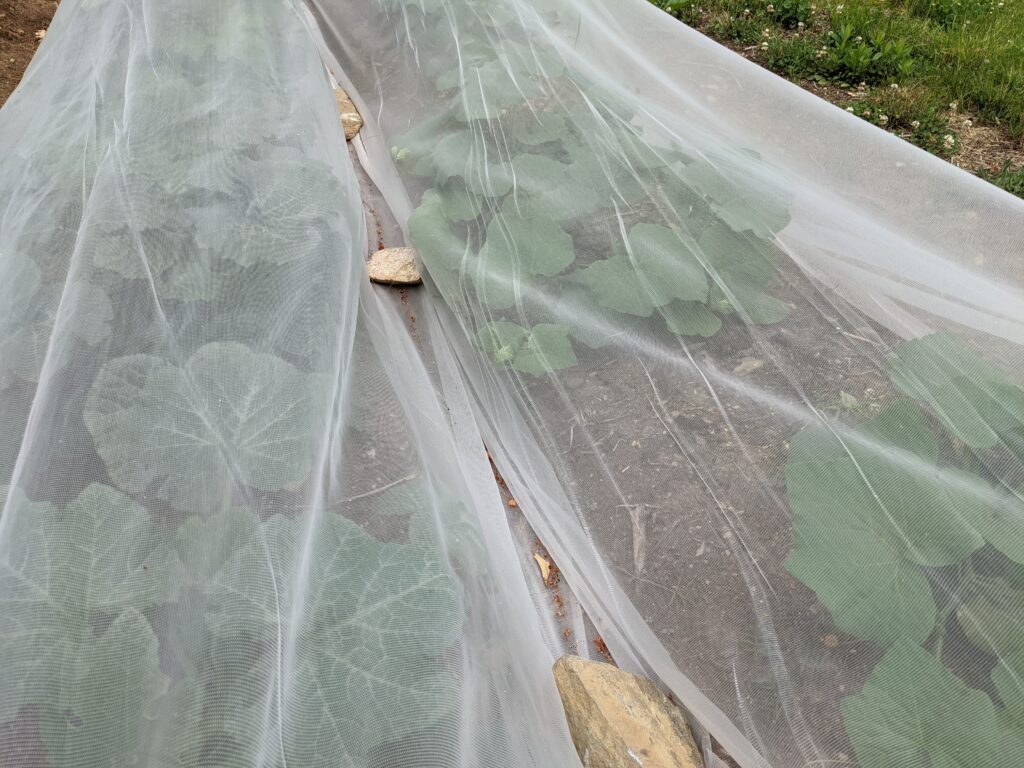
Pest: Striped cucumber beetle (Acalymma vittatum)
Pest/disease identification and lifecycle, most common damage symptoms and crops affected:

Striped cucumber beetle is our most serious early-season pest in cucurbit crops. These beetles spend the winter in plant debris in field edges and with the onset of warm days and emergence of cucurbit crops they rapidly move into the field. Densities can be very high, especially in non-rotated fields or close to last year’s cucurbit crops. Adult feeding on cotyledons and young leaves can cause stand reduction, delayed plant growth, and reduced yield. Adult feeding can also leave scarring on cucumber fruit, sometimes causing them to grow in a banana shape. Harder to see is the impact of larvae feeding on plant roots, after adults lay eggs at the base of the plants. Importantly, the striped cucumber beetle vectors Erwinia tracheiphila, the causal agent of bacterial wilt, and this can be much more damaging than direct feeding injury.

Management options:
Cultural:
Crop rotation, planting transplants, and the use of floating row cover or exclusion netting are cultural controls that help reduce the impact of cucumber beetles. Many growers use row covers on cucurbits for both growth benefit and insect protection, and remove them when flowering begins to facilitate pollination. Parthenocarpic varieties have been bred for some cucurbit species, particularly cucumbers, and seeing as these varieties can bear fruit without pollination some growers opt to leave them covered except for harvest. Similarly, very small-scale growers may consider hand-pollinating and re-covering long season cucurbit crops like winter squash or melons. These strategies can be particularly helpful in spots with a history of heavy pressure from multiple cucurbit pests (such as squash bugs and squash vine borers).

Use of row cover or exclusion netting can help growers avoid early season infection with wilt. Cucurbit plants at the cotyledon and first 1-2 leaf stage are more susceptible to infection with bacterial wilt than older plants, and disease transmission is lower after about the 4-leaf stage. Using row covers to keep the beetles out at this most vulnerable stage can be very effective.
On small scales, adult beetles can be removed by hand, or even vacuumed up with a handheld vacuum — they tend to aggregate on or in flowers.
Pesticides approved for use in certified organic production (as a last resort):
Beetle numbers should be kept low, especially before the 5-leaf stage. Uncovered crops should be scouted frequently (at least twice per week before emergence, and for two weeks after crop emergence) and treated after beetles colonize the field. The threshold depends on the crop. To prevent bacterial wilt in highly susceptible crops such as cucumber, muskmelons, summer squash and zucchini, beetles should not be allowed to exceed one beetle for every two plants. Less wilt-susceptible crops (C. moschata species squash, such as ‘Butternut’ and most pumpkins) will tolerate one or two beetles per plant without yield losses. Spray within 24 hours after the threshold is reached.
Insecticides that are allowed in organic production (listed by OMRI, the Organic Materials Review Institute) include kaolin clay (Surround WP), pyrethrin (PyGanic Crop Spray 5.0 EC), and a mixture of pyrethrin and azadiractin (Azera). Surround should be applied before beetles arrive because it acts as a repellent and protectant, not a contact poison. With direct-seeded crops, apply as soon as seedlings emerge if beetles are active. Transplants can be sprayed before setting out in the field.
Perimeter trap cropping with a variety that is preferred by the beetles (usually a C. maxima variety such as ‘Blue Hubbard’ or ‘Buttercup’) can give excellent control with a dramatic reduction in pesticide use. For details on using perimeter trap cropping, see Connecticut IPM Program’s Directions For Using a Perimeter Trap Crop Strategy to Protect Cucurbit Crops.
Please note: This information is for educational purposes. Any reference to commercial products, trade or brand names is for information only, and no endorsement or approval is intended. Pesticide registration status, approval for use in organic production and other aspects of labeling may change after the date of this writing. It is always best practice to check on a pesticide’s registration status with your state’s board of pesticide control, and for certified organic commercial producers to update their certification specialist if they are planning to use a material that is not already listed on their organic system plan. The use of any pesticide material, even those approved for use in organic production, carries risk — be sure to read and follow all label instructions. The label is the law. Pesticides labeled for home garden use are often not allowed for use in commercial production unless stated as such on the label.
Source material attribution: Modified from the UMass. Vegetable Newsletter, originally written by Ruth Hazzard and Andrew Cavanagh.
